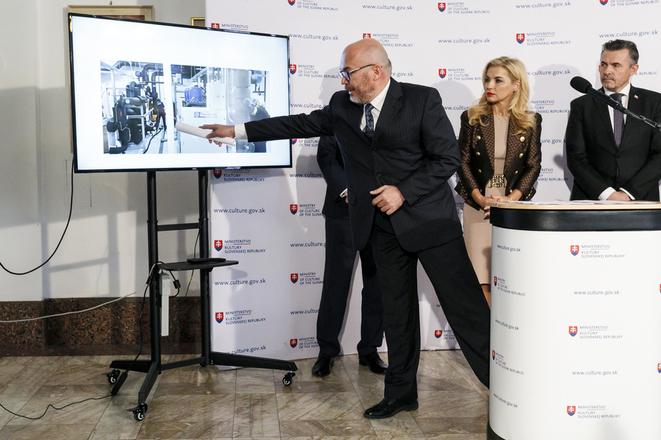Heavy rain has seeped into the National Gallery (SNG) in Bratislava, situated on the Danube riverbank, where water levels reached an unusual 9.8 metres.
Culture Minister Martina Šimkovičová, a nominee of the far-right Slovak National Party (SNS), blamed the leaks on Alexandra Kusá, the former director under whose tenure the gallery underwent reconstruction. Šimkovičová dismissed Kusá in August. Earlier this week, the minister ironically described her as a “managerial marvel”. The decision to dismiss Kusá sparked mass protests after the minister failed to provide a convincing explanation for her decision.
At a press conference on September 17, Šimkovičová appeared alongside the gallery’s interim director, Anton Bittner, an instructor in Tao healing, and Lukáš Machala, the minister’s chief of staff, widely considered to be the ministry’s real decision-maker. Several other senior ministry officials were also present.
The Culture Ministry and the current SNG leadership claimed that the gallery’s renovation had failed to resolve the issue of groundwater seepage, a problem exacerbated by the gallery’s location in a flood zone.
“We now find ourselves in a situation where not only is rainwater leaking in, but groundwater is pushing up,” Šimkovičová stated.
The SNG underwent a comprehensive renovation from 2016 to 2022 and was reopened to the public in December 2022. A renovated section of the gallery, known as “The Bridge” (Premostenie), located on the Danube’s embankment, had been closed since 2001 due to previous water leaks.
Kusá, still a curator at the gallery, dismissed the allegations as part of a “calculated smear campaign”.
“I cannot shake the feeling that this is an awkward, deliberate attempt by the current interim director, who has spent two months searching for a crisis within the gallery,” Kusá told Denník N.
She and other staff maintain that the gallery is not in a state of crisis.
While the gallery remains closed due to the leaks, Kusá claims the damage is minimal, and there is no need for its closure. Bittner, however, told reporters that staff are dealing with leaks from the roofs and pumping water from the basement.
“We’re currently pumping groundwater at a rate of 25,000 litres per hour, with round-the-clock operations,” Bittner said on Tuesday.
Two construction companies responsible for the gallery’s renovation, Hornex and Strabag, decided to inspect the critical areas on Monday. They attributed the leaks to a combination of extreme rainfall and strong winds, which caused a seal failure at the junction between the roof and a side wall.
“We apologise to the SNG and the public for the leaks, and we will rectify the issue shortly,” the companies said in a statement to SME.
The companies also noted that they had warned the gallery during the project that the proposed solutions would not ensure complete waterproofing of the basement, especially during periods of extreme Danube water levels. This had been accepted by the gallery.
In contrast, Bittner accused the previous gallery leadership of ignoring expert reports highlighting inadequate waterproofing measures. Neither the construction firms nor Kusá acknowledge any such reports. Kusá countered by calling Bittner’s claim “disinformation”, insisting that the basement is equipped with drainage channels to handle groundwater, a “normal controlled process”. Kusá further explained that the reconstruction project was designed with the city’s flood protection measures in mind, accounting for extremes.
All areas housing artworks are located above ground level. Crucially, no artworks were damaged during the recent extreme weather, as the gallery’s storage begins on the second floor. Should the Danube overflow, the most vulnerable part of the gallery would be the library, located in the courtyard basement of the Water Barracks.
Bittner also detailed the damage caused by water to several properties under the management of the National Gallery. At Strážky Manor, groundwater has seeped in, while the Ľudovít Fulla Gallery in Ružomberok has suffered leaks on the upper floor. According to Bittner, both structural engineers and health inspectors have prohibited entry to the building due to the presence of mould. At Zvolen Castle, part of the roof is leaking. Shaubmar’s Mill in Pezinok was closed earlier this year due to an infestation of woodworm.



